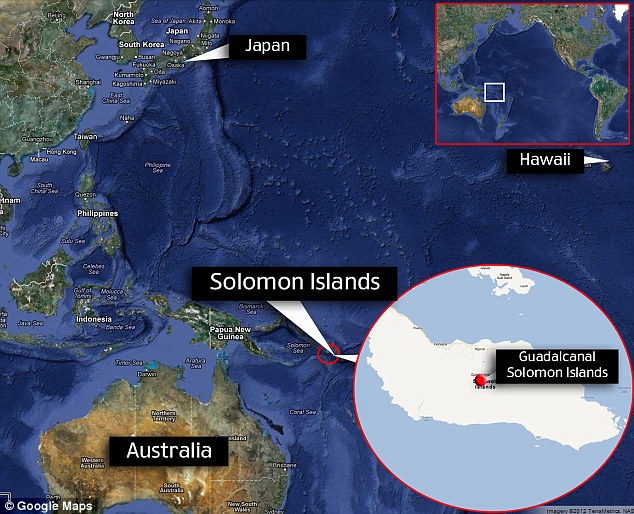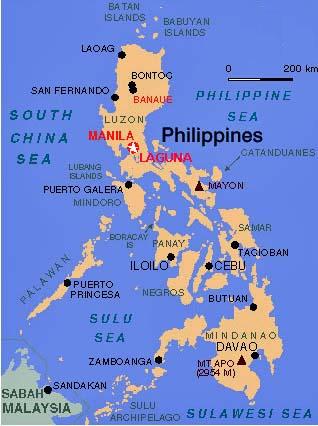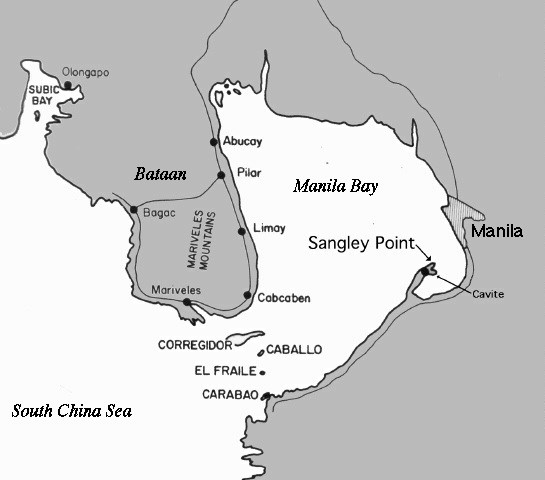World War ii Facts
part 2
1943-1945
(Part 1 1939-1942)
|
In Part 2, 1943-1945, this chronological history continues with the most salient military facts that affected every corner of the globe. The fortunes of war, with its occasional ebb and flow, began a slow upward trajectory in favor of the Allies. 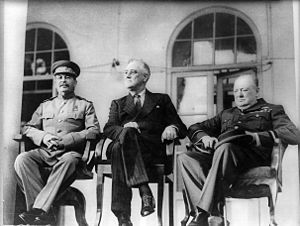 The big 3 at Teheran Conference that shaped the war and its consequences. Stalin, Roosevelt and Churchill |
World War 2 Facts World War 2 Facts
|
|
|
World War ii Facts 1943 1943 World War ii Facts
|
January: Soviets were extremely offensive minded in this first month of the new year. Their counter attacks forced the German 1st Panzer division to withdraw from southern Russia; put Germans on the defensive at Stalingrad; began to relieve the pressure of the German siege of Leningrad, and returned to the Caucus area where the Germans had been successful. President Roosevelt and P.M. Churchill meet in North Africa (Casablanca) to map war strategy and agree that nothing less than Germany's unconditional surrender is acceptable. Warsaw ghetto uprising begins. British capture Tripoli. February: General Paulus, against wishes of Hitler, surrenders all forces at Stalingrad. Kursk again controlled by Soviet army. Allies recover Kasserine Pass, Tunisia where they had previously been badly mauled. March: Germans recapture Kharkov on Eastern Front. Montgomery breaks German defensive Mareth Line (Tunisia) and forces their retreat. April: Russia begins counter offensive to recapture Crimea. Warsaw Ghetto armed uprising put down in May. Partisans in Belgium attack Holocaust train and free over 200 Jewish prisoners. May: Tunis and Bizerte fall to Allied forces. Trapped Afrika Korps surrenders. RAF dam buster bombs knock out electricity in Germany's industrial Ruhr Valley. U.S. bombs Naples. June: U.S. daytime raid on Ruhr Valley. In preparation of Sicily invasion, British take 2 nearby islands, Pantelleria and Lampedusa. U.S. bombs Kiel with heavy bomber losses. July: Invasion of Italy begins (Operation husky) in Sicily and Palermo falls to Allies. Rome is bombed and Mussolini resigns. August: U.S. North African based bombers raid Romanian oil fields. Kharkov falls to Russians. Kursk is initial Red Army success of their summer campaign. All of Sicily falls to allied forces. General Patton slapping incident will lead to his replacement. Germans reinforce Italians on Crete. September: U.S. troops attack Salerno on Italian beachhead after British success in the south. German soldiers take over Rome after Italy surrenders to Allies. Russian forces take Smolensk. American raids on Schweinfurt are so costly they suspend daylight bombing until escort fighters can accompany bombers. October: Allies take Naples after its citizens demonstrate against Germans. Poor weather stalls American drive on Rome. Partisans fight Germans in Yugoslavia and Greece. November: Russians capture Kiev. Tehran conference brings Roosevelt, Churchill, Stalin together and agree on Operation Overlord, invasion of France. December: Rommel appointed commander of Hitler's Fortress Europe. Dwight Eisenhower appointed Supreme Commander of European operations. |
January:Americans capture Buna, New Guinea. Japan now appears to have little interest to expand their existing positions in New Guinea. United States troops land in Aleutians to challenge Japanese occupation. Final U.S. push to control Guadalcanal. February: U.S. in control of Guadalcanal. U.S. IX Corps arrives in Pacific Theater. March: Allies sink 8 Japanese transports in Battle of Bismark Sea (New Guinea). British Chindit Troops forced to retreat from Burma and fall back to India. April: Japanese have continued success against British in Burma. 10 Americans escape Japanese prison camp and disclose barbarity of Bataan death march. Admiral Yamamoto killed on inspection flight over Bougainville -shot down by U.S P-38. May:Japanese bomb Australia. American troops retake Attu Island, Japanese massacre 30,000 Chinese civilians. Americans continue "island hopping" campaign in the Pacific. June: Americans land on New Georgia Islands in Solomon chain (Operation Cartwheel) July: Japanese secretly evacuate Kiska in Aleutian Islands. August: John F. Kennedy's PT 109 sunk off Solomon Islands. Americans land on Ellice islands. Japanese bomb Chungking. Chinese mainland. September: Americans maintain pressure in island campaign, and Japanese withdraw from one of the Solomon Islands. October: U.S. bombs Wake Island and Japanese retaliate and execute 98 American POWs. November: U.S. bombing raids on Rabaul (New Guinea) force Japanese to remove their planes from the island. Battle for Bougainville begins. Marines land on Tarawa in Gilbert Island chain, and bloody battle begins, but end in American victory. December: Chinese counterattack in Burma. Americans occupy New Britain. World War ii Facts Pacific Islands and Guadalcanal click to enlarge World War ii Facts 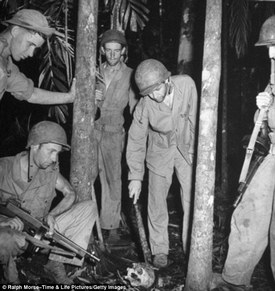 |
|
1944 January: Red Army crosses into Poland. U.S.
36th Infantry Division suffers heavy casualties crossing Rapido River
in its northward push toward Rome. Finally,in May, they gain control of
bridgehead. 45th Infantry Division fights for beachhead at Anzio which lasts 4 months. Red Army ends 900 day siege of Leningrad. February: Heavy German resistance halts American advances at Monte Cassino.. U.S. bomb and destroy ancient Monte Cassino Abbey, and claim it was used as an observation post for Germans who deny allegation. Red Army captures 2 German army corps. USSR and Finland sign Armistice, but Finland refuses peace terms a month later. U.S. Army Air Force successfully use long range P-51 fighters to escort bombers over Germany. Fighting still continues with Americans maintaining tenuous beachhead at Anzio. In May, they achieve a breakout. March: U.S. continues heavy air raids on Berlin and drop 2,000 tons of bombs. Soviet
army begins offensive operations in all areas under German control, and
reach Romanian border while the German troops occupy neighboring Hungary. Their
presence invites allied bombing in the following month. April: USSR recovers Crimea region. Allied air forces destroy Romanian oil fields. May: U.S. troops with Polish fighters take Monte Cassino. June: Allies enter Rome unopposed. D Day invasion of Normandy. Rockets hit London. Americans take Cherbourg. July: Soviets take Minsk, Belarus. British and Canadians capture Caen which Montgomery forecast to complete in a week , but panzer units delay his forces for a month. Rommel wounded when vehicle strafed. Hitler assassination plot fails. Red Army reaches Warsaw, but do not take the city until January 17 of the following year. Red Army reaches Baltic countries where resistance temporarily halts their advance. August: German 7th army and 5th Panzer encircled at Falaise, surrenders to Allies. Allies enter Paris. Field Marshal Gunther von Kluge forecasts lost war and commits suicide. Germans retreat to northern Italy to last line of defense behind "Gothic" line. September: Allies secure France and reach the German borders. Red Army enters east Germany. Soviets attack in Yugoslavia. General
Montgomery insists on an end run to cross into Germany through the
Netherlands, but unexpectedly meet stiff German resistance. Operation
Market Garden is a failure. October: Red Army enters East Germany. Allied forces land in Crete. Germans evacuate Athens and British soldiers enter city. American forces take first major German city, Aachen. Field Marshal Rommel accused in Hitler bomb plot is given ultimatum: he accedes and commits suicide. November: Belgium freed. Germans withdraw from Greek mainland and retain control over some Aegean islands until wars end. December: Himmler orders that gas chambers be destroyed in Auschwitz. Battle of Bulge begins in Ardennes Forest. Belgian city, Bastogne held by Americans and surrounded by the enemy refuses to surrender. Eight days later siege is broken. Weather
clears and American planes and ground counterattack breaks German offensive.
However, Germany is still not defeated. Fighting continues and Americans
cannot claim victory in Battle of Bulge until mid January. World War 2 Facts |
1944 World War ii Facts January: Filipino guerillas active against Japanese. British troops capture critical Burmese port. Maungdaw. Americans invade Kwajalein Island in Marshall chain. Navy carrier planes bomb Marshal Islands. February: 4th Marine division captures Roi after heavy fighting for one week. Naval planes bomb Eniwitok Atoll to soften it up prior to invasion of this Marshall Island. Hundreds of carrier planes bomb Truk in the Carolinas group--an island believed by the Japanese to be impregnable. Chinese nationalists trained by General Joseph Stillwell gain ground against Japanese in Northern Burma. Most northern of Japanese home land island, Kuril, bombed by U.S. naval planes. Americans hit Japanese merchant supply ships, and surprisingly,a tactic not used by the Japanese. The Japanese only attack naval targets, and grant American merchant marine unimpeded access in the Pacific. Premier Tojo reacting to success of American island hopping campaign replaces army and navy commanders. General Frank Merrill, serving under General Stillwell, leads American campaign in Burma supplementing Chinese efforts. March: Japanese make first incursion into India. U.S. forces repel Japanese attack on Hill 700 on Bougainville (Solomons) and begin mopping up a battle that began in the previous year. General Ord Wingate , leader of British commandos in Burma, dies in air crash. Americans land in Admiralty Islands. April: Americans return to Philippines on Mindanao Island. American air bases in South East China imperiled by Japanese advances. American infantry push Japanese in a retreat on New Guinea. May: Americans bomb Java oil refinery and naval base. (Dutch East Indies) Americans land on Biak in Dutch New Guinea. June: Americans bomb and bombard Saipan (Marianas) preparatory to landing invasion. Battle of East Philippine seas involves largest air battle of the war. Japanese lose over 300 planes and 2 aircraft carriers. July: Saipan secured by Americans after Japanese suicide attacks kills 4300 of their soldiers. Tokyo bombed. Prime Minister Tojo resigns. Marines land on Tinian (Marianas)and after it is secured becomes B-29 base that became jumping off spot for delivering atom bomb over Hiroshima. U.S. forces attack Guam (Marianas) which had been held by Japanese since December 10, 1941. August: Guam under U.S. control. September: Marines of the 1st and 7th Divisions in battle in heavy jungle on Pelelieu (Palau Islands) and suffer heavy casualties. October: U.S. bombs Formosa. Pacific fleet carrier planes bomb Okinawa. Americans ashore on Leyte Island in central Philippines. Japanese fleet decimated in East philippine Sea. November:Japanese capture Nanning but slowed in other area of china. December: Americans bomb Luzon Island, Philippines. 3 American destroyers capsize in Typhoon. World War ii Facts click to enlarge World War ii Facts |
|
1945 The German offensive aims to retake Strasbourg from the Americans. Soviets continue to drive into Prussia and by the end of the month are within 50 miles of Berlin. Soviets free Auschwitz survivors. Soviet submarine torpedoes German ship carrying wounded and 10,000 civilians . almost all die in the Baltic Sea. Roosevelt sworn in for a fourth term. February: Heavy bombing of Berlin. Roosevelt, Churchill, Stalin attend Yalta conference to discuss post war spheres of influence. Belgium liberated. Russians enter Budapest and will install communist government. German army eliminated west of Rhine River. Dresden fire bombed and burned to the ground. March: Remagen Bridge collapses and kills 28 U.S. engineers. U.S. troops cross Rhine. Himmler replaced as commander of German forces that defends Berlin. Patton forces capture Mainz, Germany. RAF raids Gestapo HQ in Copenhagen to aid Danish resistance fighters. Allies on western front intentionally slow advance to allow Russians to enter Berlin first. Red Army captures Danzig. Eisenhower demands unconditional surrender. April:German army in Ruhr Valley surrenders. Allies carry fight to Italy's Po Valley in north. Americans liberate Buchenwald concentration camp. President Roosevelt dies April 12. Harry S. Truman sworn in as new president. Will make the most fateful decision of the war. Soviet army reaches Berlin suburbs. Hitler blames generals for incompetence and vows to defend Berlin. Hermann Goring unsuccessfully attempts to take over reigns of government. Allies trap German army at Bologna and signals end of Italian war. U.S. and Red armies link at Elbe River and celebrate. Mussolini and mistress shot by Italian partisans and hung to display bodies. Hitler and Eva Braun marry and appoints Goebbels his successor. Then he and Braun commit suicide. May: Goebbels attempts to obtain surrender terms and fails. He, his wife and children commit suicide. Berlin unconditionally surrenders to Red Army and followed by surrender of their forces throughout Europe. Formal surrender at Eisenhower HQ in Rheims, France. Himmler commits suicide. World War ii Facts |
1945 World War ii Facts January:U.S. bombers hit bridges in Thailand. Navy bombards Formosa. Japanese retreat in Burma. Americans land on Luzon, Philippine island. February: Japanese devastate Manila and massacre civilians as American forces drive on the city. Navy bombards Tokyo and Yokohama. Paratroops land on Corregidor and battle Japanese. Americans invade Iwo Jima. Incendiary bombing of Japan. U.S. Sixth Army pacifies Manila. March: Burmese road link to China and India cleared. Mandalay, Burma liberated. Japanese depose their allied Vichy government in Vietnam and install their own. Burmese revolt led by their National Army against Japanese. After 1 month battle, Iwo Jima secured. April: Critical Battle for Okinawa begins. Necessary as a base to launch land invasion of Japan. Ernie Pyle, war correspondent killed by sniper on Okinawa. May: Americans with aid of Philippine guerillas battle Japanese in southern islands. Battle for Okinawa still rages. Australians invade Borneo. British forces return to Burma. June: Americans attack Japanese air bases. Typhoon strikes U.S. fleet and is heavily damaged. U.S. bombs Osaka. Japan in full retreat in China. Admiral Ota Minoru commits Hari Kari for failure to hold Okinawa. United Nations charter signed in San Francisco Japanese continue kamikaze raids on U.S. navy. July: MacArthur declares Philippines freed but fighting continues. Italy declares war on Japan. Japanese battleship Haruna sunk. USS Indianapolis delivers atomic material to Tinian from where atomic bombing raid will be launched. Ship later torpedoed, sunk with great loss of life. August: President Truman approves use of atomic bombs believes it will save a million American soldiers lives if Japanese invasion necessary. Enola Gay drops first atomic bomb on Hiroshima. Followed by second drop on Nagasaki. Soviet Army invades Korea. Emperor Hirohito agrees to unconditional surrender and General MacArthur takes over Japanese government. September 2: Unconditional surrender ceremony aboard USS Missouri. |
World War ii Facts World War ii Facts
References and Sources:
Axelrod, Alan. The real History of world War II. Sterling Publishing, Inc. New York 2008.
Chang, Iris. The Rape of Nanking. Basic Books. New York 1997.
DeKay, James T. Roosevelt's Navy, First Pegasus Books, New York, 2012.
Great Battles and Leaders of the Second World War. Giordano Bruno, Editor Houghtton Mifflin Company 1999.
MacDonald, Callum. The Killing of SS Obergruppenfuhrer. Reinhard Heydrich, The Free Press, New York 1989.
O'Neill, William L. World War II, A Student Companion. Oxford University Press, New York 1999.
Overy, Richard. Why the Allies Won. WW Norton & Co. New york 1995.
Ryan, Cornelius. The longest Day. Simon and Schuster, Inc. New York 1959.
Williamson, Murray. Belknap press. Massachusetts 2000.
We are indebted to the Library of Congress World War II Companion, and recommend it to those readers who wish to delve further into World War 2 Facts to use this book for further study.
We also thank Wikipedia for their help with the chronology.
Note: For more information on significant persons: https://www.truepeoplesearch.com/find/content-important-people-of-world-war-ii
World War ii Facts
Associated Pictures of World War 2:
Part 1: 1939-1940
Part 2: 1941-1942
Part 3: 1943
Part 4: 1944
Part 5: 1945
American Wars | Causes of World War 2 | World War ii Facts World War ii Facts
